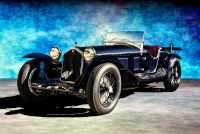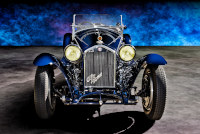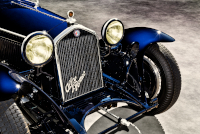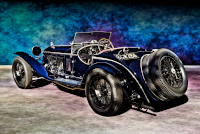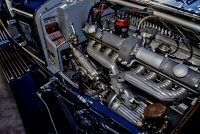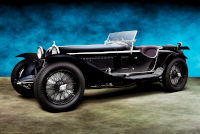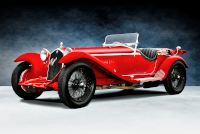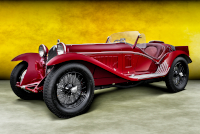Location:
Amelia Island Concours d'Elegance, 2025
Radnor Hunt Concours d'Elegance, 2015
Owner: Bruce Rudin | Montchanin, Delaware
Prologue:
"The world doesn't need another picture of an 8C Alfa."
"Yes it does." So said Phil. "I need to see an 8C every day."
To the extent that few 8C Alfa Romeo cars exist, the value of bringing to life one more is almost practical. Part of the Hyman Ltd team, Phil Metcalf brought #2211127 out to Florida along with a 1907 Columbia electric carriage. He and Joe could be seen throughout the weekend happily trotting the cars around Amelia. And Phil spoke very highly of Dr. Bruce Rudin, whose decades-long project sourced craftsmen and original components from around the globe to assemble a car that is as close to correct as possible. So we ascribe #2211127 to the chassis based on this assemblage. The parts are rare and the fit and finish exceptional, so this 8C Alfa becomes representative of a new-old classic genre, a motorsport toy that fits into a niche category of historically accurate resurrections.
The result is not an original factory product, but a product of original componentry brought to completion through complementary techniques. The alternative, if we don't consider the car to be #2211127, is to say that it doesn't exist at all. In some sense that could be true, but as this vehicle is everything that remains I prefer to see the glass half-full.
Keeping to this philosophical bent, in recent days I spoke with an artist friend of mine about the value of art. To me, the question of 'why' pursue a design project such as 12cylinders is critical, and as best as my friend and I conclude the only valid reason is to serve a community of interest. Phil and Joe, for example. But then to try at all can be perilous. I find myself at constant risk of being banal, or worse, incorrect. And in this respect, Phil endured a dose of fuddery as I struggled to pull my mind out of Maserati world and back into Alfa Romeo specifics.
When I first spotted the car at Amelia, I commented that its story sounded familiar in terms of the parts involved and global supply chain. And when I mentioned that it reminded me of a car owned by a man from Delaware named Bruce, Phil asked, "Was it black?" Of course I said it was, and with a wry smile he said, "It's this car."
As he explained, the paint is truly dark blue, but appears black under grey conditions. (The same can be said for the former Oscar Davis 8C 2900B Touring Spider, #412027.) So I had spotted the small bracket fixed to the steering box color-matched to the firewall, the Zagato-style kickout flange on the bonnet that differs from the Touring cars, the position of the Siata adjustable dampers in the cockpit, the upholstery color, all cues that reminded me of a car I had seen before. But I didn't believe my eyes. In any case, we got that mess straightened out.
So, to the man who wishes to see an 8C every day, here are a few more images—perhaps needless or perhaps not. I've taken the opportunity to emphasize the color and glow of Florida's afternoon sun, which at the very least I hope reminds you of your time with the 8C at Amelia Island.
- - - - - - - - - -
► Image Source: Nikon D750 (24.3 MP)
References:
- Czap, Nick. "Museo Storico Alfa Romeo: The catalogue" Giorgio Nada Editore, Milano, Italia. 2015, page 57
- Hyman Ltd: A good description of the car, and very good inside-out gallery.
Hyman Ltd summarize the story tracked down by Simon Moore, that chassis #2211127 began life with coupe coachwork by Letourner et Marchand, but suffered an accident in 1934. The motor and chassis survived the war, then became separated during repair and ultimately disappeared. The whereabouts of any original components from this car remained unknown for the rest of the 20th century.
In the early 2000s, "chassis parts believed to be from 2211127" emerged and subsequently became the kindling around which a new car would be built. Apparently the original chassis number survives on a frame member used in the final product, though the piece has been grafted at a point that cuts through the stamping, obscuring the complete number. Nevertheless, the build uses a large number of period mechanical components topped by a reproduction body, with contributions from a host of international specialists.
Auto Restorations Ltd of Christchurch, New Zealand built up the rolling chassis. Jim Stokes Workshops Ltd of Waterlooville, England built the motor using original parts, including a competition 2.6-litre crankcase, and then sent the unit to Christchurch to be married with the chassis. Receiving the rolling chassis in the US, the oft-cited D.L. George Coachworks Ltd of Cochranville, Pennsylvania completed the final assembly and sorting. Gary Yates of England crafted the body based on chassis #2111034, along with the benefit of an original 8C bonnet. And the late Gary Maucher of Yardley, Pennsylvania provided the upholstery.
For so much effort, it is worthwhile to profile re-built cars as they comprise an important and not insubstantial portion of the classic car world. In many cases, communities of interest suss out the numbers game, bringing chassis and motors together across the continents. But sometimes the pursuit of genetic purity slips behind the simple desire for a beautiful performance vehicle, something representative of history in both the way it looks and the way it drives. And in the case of machinery that was dismantled so early in life, the result here is nothing short of bionic.
Motor: 2,336 cc, straight 8-cylinder, alloy block, aluminum hemi-head | 65 mm x 88 mm | 6.6:1 compression
This car uses an original competition-spec 2600 crankcase formed out of magnesium, a rarity particular to a few 8C Monza cars with uprated 2,556 cc motors.
Valvetrain: DOHC, 2 valves per cylinder, gear-driven via a central mechanism between each 4-cylinder block
Aspiration: Memini S152 carburetor, Roots-type supercharger
Power: 165 bhp at 5,200 rpm
Drivetrain: 4-speed gearbox, rear-wheel drive
As a rebuilt car in need of authentic components, chassis #2211127 uses a similar 6C 1750 gearbox.
Front Suspension: beam axle, semi-elliptic leaf springs, friction dampers
Rear Suspension: live axle, semi-elliptic leaf springs, Siata shock absorbers
Architecture: pressed steel chassis based on original components of #2211127 with reproduction aluminum body by Gary Yates
Kerb Weight: 1,000 kg (2,205 lbs)
Wheelbase: 2,750 mm (108.3 inches)
Top Speed: 185 km/h (about 115 mph)
Etymology:
'8C 2300' refers to the motor, a straight 8-cylinder of about 2.3 litres displacement. 'Corto' refers to the short chassis, (as opposed to 'lungo'). 'Mille Miglia' references Alfa's recent dominance in the 1,000-mile race, although the first group of 8C 2300 cars arrived too shortly before the 1932 race and had not been well enough prepared, leaving the business of winning the race to subsequent years, which indeed came good in 1933 and 34. The term 'spider' descends from the carriage trade, which in motorcar terminology refers to open sports cars. 'Zagato' identifies the Milanese coachbuilder who bodied many classic Alfa racing cars in lightweight aluminum coachwork, although in this case the aluminum body is an evocation of the original design.
Figures:
We've cited many different figures throughout the development of this portfolio, the largest of which is the factory's own figure of 308 total 8C 2300 cars produced between 1931 and 1934, comprising all manner of road and racing variants. The number of long and short-chassis racers seems as if it shouldn't be too great, and yet I continually stumble across chassis I haven't seen before, to say nothing of the registries that log many dozens of disparate examples. Suffice to say, this corto chassis is one of many, though the classic car world still wishes there were more.
Value:
This 8C 2300 appeared for sale at Hyman Ltd in 2024 for $1,750,000. The price more closely reflects the collective effort of specialists around the world to piece the car together over the course of many years, apart from its value as a historical artefact.
Rebuilt Body: Characteristic Zagato Shape in Reconstruction
Compared with its authentic bretheren, as in the 1931 Zagato-bodied spider in our portfolio, the new coachwork looks very well executed. The running gear leap at the proper height, to the proper degree, and the linear elements follow the correct pattern. The plan carries over from the 6C 1750 Zagato spider, the dimensions between the two being so similar.
Somehow, the form is still immediately recognizable to me as a fabrication, though perhaps only in its extraordinary finish. The alignment, contour, and paint are so nice and proper that it would be difficult to believe the coachwork is original at a glance. In sum, the car is well enough constructed to have received a class award at Amelia Island, whereas my observations are strictly aesthetic; one cannot fault the car's appearance in any way other than it is too good.
Acknowledging that the coachwork is faithful to the original and beautiful to a fault, it's worth pointing to the shape of the door, which, apart from the linear body, provides angular hints in the leading edge and curved chrome trailing edge. The door is the most obvious styling gesture on the Zagato-bodied 8C, and I like that Mister Yates did not overlap the door sill with leather, keeping the curves bare and accentuating the elbow joint—the point of convergence among the sill, the chrome belt line, the chrome on the trailing edge of the door, and the brace that frames the cockpit. With four bright edges meeting at one point, a spot of cleverness emerges in Zagato's design.
Touring Comparison: Comparing the 1932 8C 2300 Mille Miglia Cars by Touring and Zagato
Zagato's simplicity versus Touring's glam... the former might seem adequate, and yet Touring cleaned up some inherent awkwardness in the shapes and panel cuts necessitated by the windscreen and doors. The Zagato design typically uses a rectangular, two-piece windscreen, which appears upright when fixed but folds quite usefully for fast driving. More sophisticated than a large metal frame, the Touring design uses lovely, curved, form-fitting glass with wind-wings, altogether more rakish.
As for the door, Zagato cut down the sill with a handsome curve, but not so deeply as Touring. And where the linear chrome of the Zagato design gets in the way of the door gap along the leading edge, (the edge actually slices through the chrome brightwork), Touring's French sweep dives gracefully below the sill. That French sweep hides Touring's door handle, whereas, to Zagato's credit, they removed the handle altogether. But then, Touring's design uses a more sophisticated hinge arrangement, nearly flush with the body compared to Zagato's protruding barrel hinges.
Back and forth, both designs offer subtle advances in cleanliness and finesse, with preferences tilted toward Touring as the car with a more cohesively rendered idea. Again, Zagato largely update the 6C 1750 plan, rendering a classic shape with minimally intrusive details.
Siata Shocks: Adjustable Suspension Upgrade for the Period 8C 2300
Also true of the 1932 8C 2300 Corto Touring Spider, this 8C 2300 rides on adjustable rear Siata shock absorbers, provisions of the accessory manufacturer in the days before they made complete cars. As the knob indicates, the driver can adjust the rear shocks remotely, (which is exactly what the seal reads in Italian), not unlike a contemporary sports car.
Motor Comparison: Details of the 8C 2300
Reviewing the 1932 8C 2300 Corto Touring Spider, we can find numerous idiosyncrasies in the two motors' presentation. In this spot-the-difference game, we rather believe that the Touring Spider represents the perfect state, whereas this chassis here marries different components. Differences appear around the steering box and low along the crank; these are differences in tubing most notably, though I like the delicate, two-pronged brace connected to this car's steering box, with its grey-blue color matched to the bulkhead.
Last Updated: Mar 26, 2025

